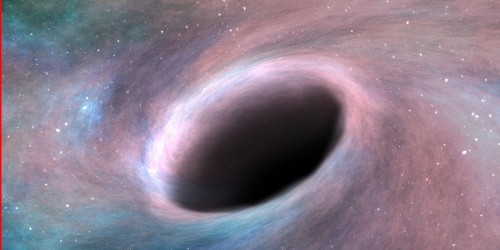A black hole is formed when a gargantuan star dies and its core collapses into a space so infinitesimally small that not even light can escape it. The interface that defines the point of no return is called the event horizon. A rough analogy to describe this entity would be a sort of opaque "wrapping" that doesn’t let you see the singularity itself. Importantly, as matter falls into the black hole, the event horizon grows: rapidly at first as the black hole begins to form, then more slowly as matter falls in at a lower rate.
During the first trillionth of a second after the Big Bang, the universe expanded incredibly rapidly — faster than the speed of light. Since the universe was essentially in its initial stages of formation, the universal speed limit didn’t have much importance. As time progressed, the expansion gradually decreased. Practically, our universe could be the event horizon in some other universe’s black hole!
Keeping in mind the enigmatic nature of this occurrence, there are a few catches or rather, puzzling facts. Three-dimensional black holes in our universe have two-dimensional event horizons. That means for our universe to be an event horizon, it had to have been born out of a four-dimensional black hole in a four-dimensional universe. Pushes the confines of your mind doesn’t it?
Sadly, we cannot calculate what happens in a black hole’s singularity. The very principles of physics crumble or "collapse" as we venture into the nature of a black hole. Conveniently though, we can calculate what happens on the boundary of an event horizon. As matter falls into the black hole, the event horizon encodes that information.
The black hole and the event horizon grow so that the surface area is the exact right size to contain the information for all of the matter that has ever fallen in since the black hole’s creation. All that information could translate to everything that exists in our universe. Although black holes have proven to be a physicist’s ultimate conundrum, the math behind the occurrence adds up and solves many intriguing problems.
Or so say researchers at the Perimeter Institute and the University of Waterloo, who first proposed this possibility back in 2014. One big problem with the Big Bang, according to The Perimeter Institute, "is that the big bang hypothesis has our relatively comprehensible, uniform, and predictable universe arising from the physics-destroying insanity of a singularity. It seems unlikely."
The black hole hypothesis is fairly clear, although admittedly it pushes the confines of our mind to places we cannot envision. We might live in a universe within a black hole within a universe within a black hole. It might be an infinite chain of black holes with no visible end. Is our existence present in an infinite string of cosmos? That paints quite a terrifying picture doesn’t it!

The universe we know, theoretically started out as an infinitely hot and dense spot called a singularity. But hey, that sounds oddly similar to what we now call black holes doesn’t it? Physicists have theorized that these could be interconnected or rather, one and the same. The singularity in every black hole might give birth to a baby universe. The inception of our mighty universe could potentially have its roots embedded in what is now, the most enigmatic cosmic phenomena!




